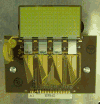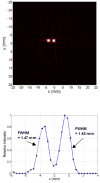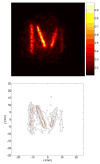A prototype of very high resolution small animal PET scanner using silicon pad detectors
- PMID: 18084629
- PMCID: PMC2140047
- DOI: 10.1016/j.nima.2006.10.277
A prototype of very high resolution small animal PET scanner using silicon pad detectors
Abstract
A very high resolution small animal positron emission tomograph (PET) which can achieve sub-millimeter spatial resolution is being developed using silicon pad detectors. The prototype PET for a single slice instrument consists of two 1 mm thick silicon pad detectors, each containing a 32 x 16 array of 1.4 mm x 1.4 mm pads read out with four VATAGP3 chips which have 128 channels low-noise self triggering ASIC in each chip, coincidence units, a source turntable and tungsten slice collimator. The silicon detectors were located edgewise on opposite sides of a 4 cm field-of-view to maximize efficiency. Energy resolution is dominated by electronic noise, which is 0.98% (1.38 keV) FWHM at 140.5 keV. Coincidence timing resolution is 82.1 ns FWHM and coincidence efficiency was measured to be 1.04 x 10(-3) % from two silicon detectors with annihilation photons of (18)F source Image data were acquired and reconstructed using conventional 2-D filtered-back projection (FBP) and a maximum likelihood expectation maximization (ML-EM) method. Image resolution of approximately 1.45 mm FWHM is obtained from 1-D profile of 1.1 mm diameter (18)F line source image. Even better resolution can be obtained with smaller detector element sizes. While many challenges remain in scaling up the instrument to useful efficiency including densely packed detectors and significantly improved timing resolution, performance of the test setup in terms of easily achieving submillimeter resolution is compelling.
Figures


















References
Grants and funding
LinkOut - more resources
Full Text Sources
Miscellaneous
